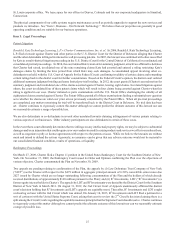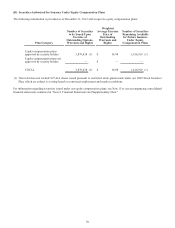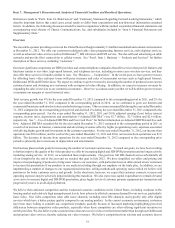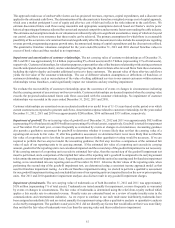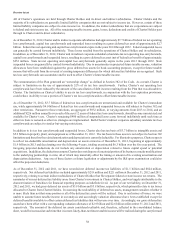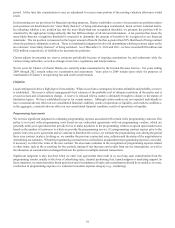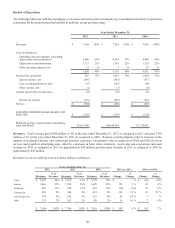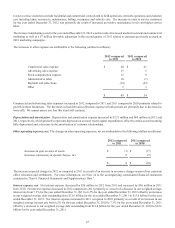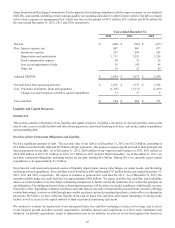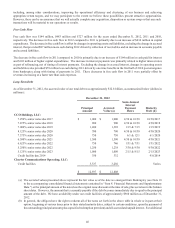Charter 2012 Annual Report Download - page 49
Download and view the complete annual report
Please find page 49 of the 2012 Charter annual report below. You can navigate through the pages in the report by either clicking on the pages listed below, or by using the keyword search tool below to find specific information within the annual report.37
This approach makes use of unobservable factors such as projected revenues, expenses, capital expenditures, and a discount rate
applied to the estimated cash flows. The determination of the discount rate is based on a weighted average cost of capital approach,
which uses a market participant’s cost of equity and after-tax cost of debt and reflects the risks inherent in the cash flows. We
estimate discounted future cash flows using reasonable and appropriate assumptions derived based on Charter’s and its peers’
historical operating performance adjusted for current and expected competitive and economic factors surrounding the cable industry.
The estimates and assumptions made in our valuations are inherently subject to significant uncertainties, many of which are beyond
our control, and there is no assurance that these results can be achieved. The primary assumptions for which there is a reasonable
possibility of the occurrence of a variation that would significantly affect the measurement value include the assumptions regarding
revenue growth, programming expense growth rates, the amount and timing of capital expenditures and the discount rate utilized.
The quantitative franchise valuations completed for the years ended December 31, 2011 and 2010 showed franchise values in
excess of book values and thus resulted in no impairment.
Impairment and amortization of customer relationships. The net carrying value of customer relationships as of December 31,
2012 and 2011 was approximately $1.4 billion (representing 9% of total assets) and $1.7 billion (representing 11% of total assets),
respectively. Customer relationships, for valuation purposes, represent the value of the business relationship with existing customers
(less the anticipated customer churn), and are calculated by projecting the discrete future after-tax cash flows from these customers,
including the right to deploy and market additional services to these customers. The present value of these after-tax cash flows
yields the fair value of the customer relationships. The use of different valuation assumptions or definitions of franchises or
customer relationships, such as our inclusion of the value of selling additional services to our current customers within customer
relationships versus franchises, could significantly impact our valuations and any resulting impairment.
We evaluate the recoverability of customer relationships upon the occurrence of events or changes in circumstances indicating
that the carrying amount of an asset may not be recoverable. Customer relationships are deemed impaired when the carrying value
exceeds the projected undiscounted future cash flows associated with the customer relationships. No impairment of customer
relationships was recorded in the years ended December 31, 2012, 2011 and 2010.
Customer relationships are amortized on an accelerated method over useful lives of 11-15 years based on the period over which
current customers are expected to generate cash flows. Amortization expense related to customer relationships for the years ended
December 31, 2012, 2011 and 2010 was approximately $280 million, $306 million and $331 million, respectively.
Impairment of goodwill. The net carrying value of goodwill as of December 31, 2012 and 2011 was approximately $953 million
(representing 6% of total assets) and $954 million (representing 6% of total assets), respectively. Goodwill is tested for impairment
as of November 30 of each year, or more frequently as warranted by events or changes in circumstances. Accounting guidance
also permits a qualitative assessment for goodwill to determine whether it is more likely than not that the carrying value of a
reporting unit exceeds its fair value. If, after this qualitative assessment, we determine that it is not more likely than not that the
fair value of a reporting unit is less than its carrying amount then no further quantitative testing would be necessary. If we are
required to perform the two-step test under the accounting guidance, the first step involves a comparison of the estimated fair
value of each of our reporting units to its carrying amount. If the estimated fair value of a reporting unit exceeds its carrying
amount, goodwill of the reporting unit is not considered impaired and the second step of the goodwill impairment is not necessary.
If the carrying amount of a reporting unit exceeds its estimated fair value, then the second step of the goodwill impairment test
must be performed, and a comparison of the implied fair value of the reporting unit’s goodwill is compared to its carrying amount
to determine the amount of impairment, if any. Reporting units, consistent with the units of accounting used for franchise impairment
testing, were consolidated into one reporting unit as of November 30, 2012. Likewise the fair values of the reporting units, when
performing the second step of the goodwill impairment test, are determined using a consistent income approach model as that
used for franchise impairment testing. As with our franchise impairment testing, we elected to perform a qualitative assessment
for our goodwill impairment testing and concluded that none of our reporting units are impaired based on the new or prior reporting
units. Our 2011 and 2010 quantitative impairment analyses also did not result in any goodwill impairment charges.
Impairment of trademarks. The net carrying value of trademarks as of both December 31, 2012 and 2011 was approximately
$158 million (representing 1% of total assets). Trademarks are tested annually for impairment, or more frequently as warranted
by events or changes in circumstances. The fair value of trademarks is determined using the relief-from-royalty method which
applies a fair royalty rate to estimated revenue. Royalty rates are estimated based on a review of market royalty rates in the
communications and entertainment industries. As we expect to continue to use each trade name indefinitely, trademarks have
been assigned an indefinite life and are tested annually for impairment using either a qualitative analysis or quantitative analysis
as elected by management. The qualitative analysis in 2012 did not identify any factors that would indicate that it was more likely
than not that the fair value of trademarks were less than the carrying value and thus resulted in no impairment.


